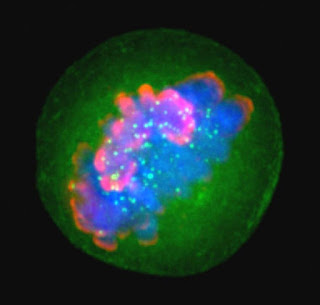A Flawless Machine in your Cells
One of the most frustrating things in doing creation science is how Darwin's Flying Monkeys™ continue to deny clear evidence of design. Worse, many will demand proof that living things were designed, but they presuppose that they only appear designed, so they refuse to consider the material. Because Dawkins. Because atheism. Because evolution.
Although the old argument of, "Every building has a builder, a painting has a painter" is incomplete (only arguing for intelligent design), it is still useful when handled correctly. The mechanism of cell division, necessary in life, testifies of the Master Engineer's genius.
 |
| The kinetocores are turquoise. Cell image by Wellcome / Laura Trinkle-Mulcahy (CC BY 4.0) |
It is amazing that materialists call it beautiful and flawless. This tiny machinery in living cells is complex and has several functions — including when to function or just hold on a spell. In their efforts to rob the Creator of proper credit, evolutionists conjure up propaganda based on speculative nonsense and "stasis", where evolution always happens except when it doesn't. Hail Darwin, Evolution, and Natural Selection, blessed be! Actually, they are suppressing the truth in unrighteousness (Rom. 1:18-24).
Andrea Musacchio has been trying to understand the kinetochore for 20 years. A research leader at the Max Planck Institute, has been driven by the motto, “Before we understand how things go wrong, we better understand why and how things work.” His team recently built a model of this complex machine that allows them to begin to understand this essential contraption that is at the center of mitosis: eukaryotic cell division.
It´s a cellular process going on since one billion years, yet we are not able to replicate it, nor to fully understand it. Mitosis, the mechanism of cell division that is so important for life, involves more than 100 proteins at its core. Now, the group of Andrea Musacchio from the Max Planck Institute of Molecular Physiology in Dortmund has been able to fully reconstitute the engine of the mitosis machinery, called kinetochore.
How well does the machine work? Here, Musacchio waxes eloquent, as if he has been watching a grand opera in a foreign language. He thinks he can now can understand all the words and see the overall plot, but still is trying to figure out the story details.
To read the rest, give your undivided attention to "Cell Biologists Describe a 'Beautiful, Flawless Machine'”. Also, there's a video on that page that you might want to see.